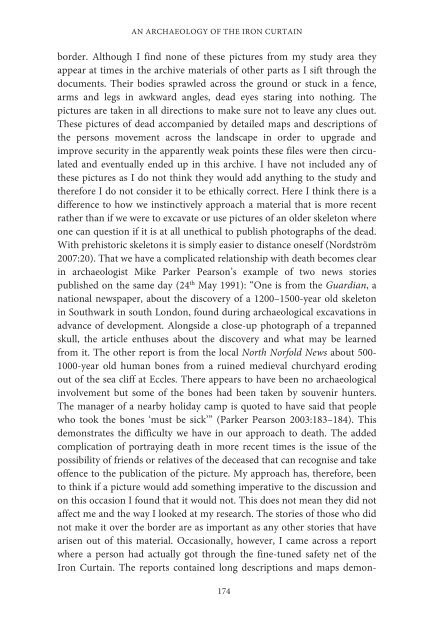1JZGauQ
1JZGauQ
1JZGauQ
Create successful ePaper yourself
Turn your PDF publications into a flip-book with our unique Google optimized e-Paper software.
AN ARCHAEOLOGY OF THE IRON CURTAIN<br />
border. Although I find none of these pictures from my study area they<br />
appear at times in the archive materials of other parts as I sift through the<br />
documents. Their bodies sprawled across the ground or stuck in a fence,<br />
arms and legs in awkward angles, dead eyes staring into nothing. The<br />
pictures are taken in all directions to make sure not to leave any clues out.<br />
These pictures of dead accompanied by detailed maps and descriptions of<br />
the persons movement across the landscape in order to upgrade and<br />
improve security in the apparently weak points these files were then circulated<br />
and eventually ended up in this archive. I have not included any of<br />
these pictures as I do not think they would add anything to the study and<br />
therefore I do not consider it to be ethically correct. Here I think there is a<br />
difference to how we instinctively approach a material that is more recent<br />
rather than if we were to excavate or use pictures of an older skeleton where<br />
one can question if it is at all unethical to publish photographs of the dead.<br />
With prehistoric skeletons it is simply easier to distance oneself (Nordström<br />
2007:20). That we have a complicated relationship with death becomes clear<br />
in archaeologist Mike Parker Pearson’s example of two news stories<br />
published on the same day (24 th May 1991): “One is from the Guardian, a<br />
national newspaper, about the discovery of a 1200–1500-year old skeleton<br />
in Southwark in south London, found during archaeological excavations in<br />
advance of development. Alongside a close-up photograph of a trepanned<br />
skull, the article enthuses about the discovery and what may be learned<br />
from it. The other report is from the local North Norfold News about 500-<br />
1000-year old human bones from a ruined medieval churchyard eroding<br />
out of the sea cliff at Eccles. There appears to have been no archaeological<br />
involvement but some of the bones had been taken by souvenir hunters.<br />
The manager of a nearby holiday camp is quoted to have said that people<br />
who took the bones ‘must be sick’” (Parker Pearson 2003:183–184). This<br />
demonstrates the difficulty we have in our approach to death. The added<br />
complication of portraying death in more recent times is the issue of the<br />
possibility of friends or relatives of the deceased that can recognise and take<br />
offence to the publication of the picture. My approach has, therefore, been<br />
to think if a picture would add something imperative to the discussion and<br />
on this occasion I found that it would not. This does not mean they did not<br />
affect me and the way I looked at my research. The stories of those who did<br />
not make it over the border are as important as any other stories that have<br />
arisen out of this material. Occasionally, however, I came across a report<br />
where a person had actually got through the fine-tuned safety net of the<br />
Iron Curtain. The reports contained long descriptions and maps demon-<br />
174




